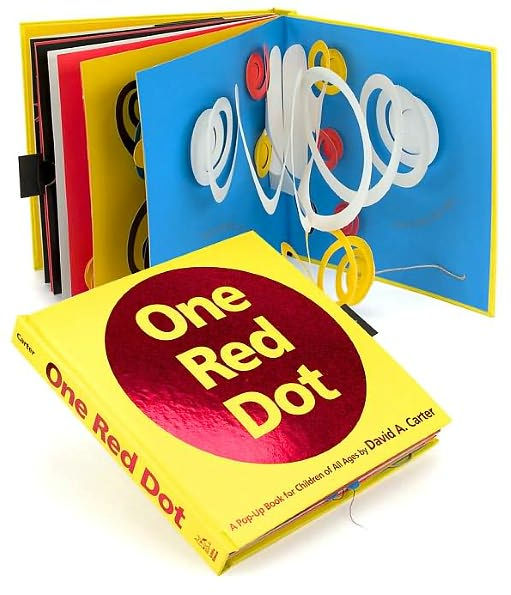Interviews
A Conversation with David A. Carter
One Red Dot is a departure from the pop-ups that you have done in the past. What inspired this new creative direction?
DC: My book The Elements of Pop Up was an attempt to refine the art of paper engineering down to the most simplified and basic pop-up structures. As I was working on these simplified structures, I also started experimenting by doing the opposite-making these structures complex. As I built these complex versions I became very excited about what was happening and decided that I had to use them in a book.
It has been mentioned that your pop-up spreads in One Red Dot are reminiscent of Alexander Calder's mobiles. Was his work an inspiration for you?
DC: I had the general idea for a book, but I was missing the big picture concept of what the book would be and how I would apply these experimental pop-ups. On a field trip with my daughter, we visited the Calder retrospective at the San Francisco Museum of Modern Art. It struck me that, like Calder's sculptures, I could present my pop-up structures simply for what they were-movable paper sculptures that were created by spontaneous self-expression. They became objects of art with no attempt to represent or symbolize anything. In other words, my new book would be pop-ups created just for the pure fun and joy of making art, which is how I imagine Calder created his work. Until the Calder exhibit I had been making the pop-ups using the traditional medium of white paper, I then began using the five basic colors of red, yellow, blue, black, and white.
Which spread was the most difficult to create?
DC: Five wiggle wobble widgets was the most difficult to create and refine to the point where I was confident that it could be manufactured successfully.
How long did the process of creating One Red Dot take?
DC: I worked on the book that would become One Red Dot over a six-year period. I had so much fun that I didn't want to finish. The book was finalized in the fall of 2003 and first published in Italy, Spain, and Japan in the fall of 2004.
One Red Dot is a counting book but also features a "hidden" red dot on each spread. Why did you decide to add this extra element?
DC: At one point, I considered offering this book as a portfolio of pop-up sculpture, but it just didn't seem right-I was looking for something more. The first spread had evolved into the puzzle box, and at one point I decided to have the viewer search for a red dot in the box. I then realized that I could have the viewer find the red dot throughout the book and that became the thread that tied the book together.
Which is the most difficult spread for most adults? Which is the most difficult spread for kids? Did this surprise you?
DC: The most difficult red dot to find is on the first spread of the foreign editions (only) of One Red Dot. The most difficult red dot for adults in the U.S. edition is on the last spread. The most challenging spread for children seems to be the third spread, but most children so far have asked me to make the next book more challenging, which I am doing. This doesn't surprise me at all. I think children are more playful and open and are not afraid of failure. I suggest that adults just try to relax and have some fun.
Do you listen to music while constructing your pop-ups? If so, what kind?
DC: I love music and I listen to all kinds when I work. I have my entire collection loaded into my G5 so at a click of a mouse, I can listen to whatever suits my mood, from Thelonious Monk to X to Edith Piaf and everything in between. And yes, sometimes I dance and sing along.
How did you first learn to make pop-up books?
DC: In 1981, I went to work for Intervisual Communications in Los Angeles. Intervisual was the pop-up book packager responsible for revitalizing pop-ups in the 1980s. When I saw the art for Jan Pienkowski's Robot, I decided then and there that if this was the kind of artwork possible for these books then this was the field that I wanted to pursue. I learned the art of paper engineering and pop-up book making while working over a seven-year period with artists such as John Strejan, Jim Diaz, Tor Lokvig, and David Pelham.
If you could work with any artist on a pop-up in the future, who would it be?
DC: If I could bring an artist back from the past, I would like to work with Henri Matisse. I think the collage work he did at the end of his life would make a beautiful movable and dimensional book. I am also very interested in the work of Marcel Duchamp, Henri Laurens, and Jean Tinguely. If I were to choose a modern-day artist to work with, I would pick the architect and sculptor Frank Gehry. I am fascinated with his work.








